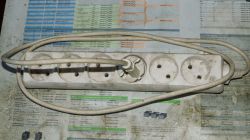Is it safe to use a pinless extension cord connected to a pin receptacle?

Czy wolisz polską wersję strony elektroda?
Nie, dziękuję Przekieruj mnie tam_jta_ wrote:If the installation has a differential fuse, it will then detect that someone has touched the housing and immediately turn off the voltage;
_jta_ wrote:An extension cord plug with pinless sockets usually does not fit into a pin socket - this pin has nowhere to enter.
_jta_ wrote:If the housing is not grounded, is not touching something grounded, or is not large enough that the current through its capacity is sufficient to trip the RCD, the same phase shorting to the housing will not trip the RCD, but most likely the RCD will trip if someone touches the RCD at the same time. this case and something grounded. Human body resistance at 230V ~ is small enough for the current flowing enough (and probably with a large margin) to trip the RCD. I hope that the RCD works quickly enough in such a situation that those who touch it hardly feel the current.
_jta_ wrote:
Besides, there are still many TN-C installations in Poland without RCDs, and they pose the greatest threat to users.
_jta_ wrote:I do not know what system, but what I see in stores does not go into the socket with a pin.
_jta_ wrote:However, I believe that in the absence of grounding, the RCD is not useless.
_jta_ wrote:
So if someone touches the phase while standing on the ground and current flows through it, this will be the differential current that the RCD will detect. And thanks to this, that someone will be exposed to the flow of current for a small fraction of a second

_jta_ wrote:
It's almost the worst if they connect L. to one grounding pin socket.
Quote:(extension cord from post # 25) poses the greatest potential risk to the user. This is because it makes it impossible to use additional protection in class I devices (in the form of protective earthing), even when powered through an extension cord from an appropriate fixed plug socket with a protective pin.
Quote:(an extension cord with a class 0 plug) poses a slightly lower risk to the user, preventing the connection of such an extension cord to fixed plug sockets with a protective pin. Nevertheless, it ensures safe use of the appliances, as with the previous extension cord design, only with regard to Class II appliances
Quote:(...) would be to allow the use of extension cords (...) with warnings attached to them that the extension cords provide an appropriate level of safety for the use of devices only in the case of:
- powering them from socket outlets without a protective pin only in the case of using devices of class II
Quote:However, I have seen (and even have) a splitter that fits with grounded sockets, and has sockets for flat plugs
